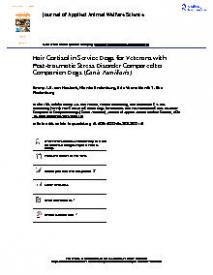Hair Cortisol in Service Dogs for Veterans with Post-traumatic Stress Disorder Compared to Companion Dogs (Canis Familiaris)
Service dogs are trained to assist humans. This assistance potentially exposes them to stressors To investigate if service dogs are exposed to more stressors than companion dogs we questioned whether hair cortisol levels differed between both groups.
We studied this by cutting a tuft of hair from the neck of 19 companion and 11 service dogs. Cortisol levels were subsequently analyzed via immunoassay and compared via a simple linear regression model. The influence of coat color, season, sex, other dogs, pets, or mental health diagnoses in the household was also checked .
Results showed that cortisol values did not differ between service and companion dogs. Furthermore, none of the additional variables had an influence on cortisol levels. This lead to the conclusion that the service dogs in this study did not have higher hair cortisol levels than companion dogs Further study should be conducted as to why no difference did occur between groups and if this difference is persistent over time given that we only studied a period of up to two months’ worth of hair cortisol.
In: Journal of Applied Animal Welfare Science : ISSN: 1532-7604 | 26 | 4 | 623-633
https://doi.org/10.1080/10888705.2022.2033119


